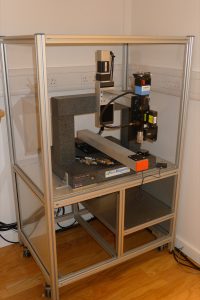Cambridge
The Godwin Laboratory for Paleoclimate Research has a long and distinguished record of research focusing on palaeoclimate reconstruction. State-of-the-art instrumentation for trace elemental and stable isotope analysis of carbonates and fluid inclusions is available.
- Thermo Scientific MAT 253 IRMS for carbonate (clumped) isotope measurements and Kiel IV carbonate preparation device
- 3 Picarro Cavity Ringdown Spectrometers for δ18O, δ17O, and δD
- Netzsch TG 449 F3 Jupiter for thermogravimetric analyses (TGA), interfaced with a Picarro L2130 CRDS for online fluid inclusion analysis
The Nanopaleomagnetic laboratory uses FORC, combined with
a suite of other measurements and analytical tools.
- Vibrating sample magnetometer (VSM)
- Alternating gradient magnetometer (AGM)
- Kappabridge susceptometer
- alternating field demagnetiser
- magnetic tunnel junction (MTJ) scanning microscope.
Waikato
Our Mass Spectrometry facility is a Bruker Daltonics Centre of Excellence, which includes a range of mass spectrometry techniques:
- MALDI-TOF Autoflex Bruker Daltonics AutoflexTM Spectrometer
- Bruker Daltonics MicrOTOFTM Spectrometer
- Two Perkin-Elmer SCIEX ELAN DRC II ICP-MS
- Resonetics – 193 nm RESOlution LA-ICP-MS
- Hewlett Packard 6890 GC interfaced with a Hewlett Packard 5973 quadrupole MS
- LC-MS coupled to a Dionex Ultimate 3000 HPLC with a photo diode array detector to a Bruker amaZon X MS (ESI or APCI source)
- IsoPrime100 gas source IRMS with PyroCube
Mainz
- NU PLASMA MC-ICP-MS equipped with three ion counters and twelve faraday cups (MPI for Chemistry, Mainz)
- Thermo Scientific ELEMENT2 double focusing magnetic sector field ICP- MS (MPI for Chemistry, Mainz)
- NWR-FEMTO femtosecond laser working with an extremely low puls width of <130 fs and 200 nm wavelength (MPI for Chemistry, Mainz)
- Two New Wave solid-state Nd:YAG lasers, 193 and 213nm wavelength, respectively (MPI for Chemistry, Mainz)
- New Wave MicroMill (Institute for Geosciences, University of Mainz)
- Setup for conduction of laboratory experiments with synthetic carbonates under controlled conditions
- Clean laboratory for sample preparation (MPI for Chemistry, Mainz)
- Dionex Ultimate 3000 UHPLC coupled to a Q Exactive Orbitrap MS
Bochum
- Gasbench + MAT253 for d13C, d18O, DIC
- TC/EA for d18O and dH
- Neptune for d26Mg, Sr/Sr, d44Ca
- coming soon: MAT253Plus and KIEL IV for clumped isotope analysis on carbonates
- ICP-AES for element ratios and concentrations
- Cave microclimate monitoring & Autosampler for dripwater
Potsdam
The Potsdam Institute for Climate Impact Research hosts a high performance computer cluster (IBM/Lenovo NeXtScale nx360M5) with state of the art Intel Haswell processors (in total 5088 CPU cores) with scalar frequencies of up to 3.4 GHz and 64 GByte DDR4 memory per compute node, reaching 212 TFlops/s. It is extended by a set of graphical coprocessors (nVidia Kepler K40 accelerators) to support development of new applications and 6 large memory compute servers (256GB RAM) available for the project. The system is completed by a high available parallel file system with 2 PByte capacity and 20 GB/s read/write bandwidth, and a non-blocking high performance FDR Infiniband network. To accomplish high energy efficiency, the computer cluster has a direct watercooling for processors and memory waste heat that is used to heat the campus’ office building(s) during winter season.
